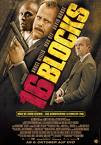
16 blocks film analysis
Setting
The film is set in a city. We know this because of the obvious urban surroundings, such as traffic, sky scraper buildings and passersby.
We are also shown that the city is New York because the police force is wearing an ‘NYPD’ labelled jacket. This identifies their positions in the film and that they are in the police department of New York.
Narrative based or character based?
The first part of the opening sequence is character based because it is based on dialogue in the beginning of the flashback. We know this as detective ‘Jack Mosley’ is stating that he is a police officer because he gives his shield number and says that it will be his “last will and testament”, which is introducing him at the end of his career. Mosley states how he was “trying to do a good thing”, which gives us clues to his character. The second part of the opening sequence starts as narrative based as it begins with samba music and shots of the apartment. The mood is then interrupted when the NYPD kick the door down along with shouting commands. This is then followed by detective Jack Mosley being asked to “sit in the case”; demonstrating to the audience he isn’t regarded very highly in his jobs due to his visible attitudes.
Genre
The genre is established because we see law enforcement officers, detectives, police, a chase or quest when the NYPD enter the apartment, mystery in the flashback and authoritative role of the police officers. The genre is also shown through the mise-en-scene as we can see guns, police hats, uniform, coats, and police lingo.
Genre is important as it relies on the audience expectation to generate meanings.
Introduction of Main Character
Jack Mosley is introduced in the flashback with a long shot but slightly tilted to a low angle. The long shot is used to allow the viewer to gain the overall picture. The slight use of the low angle is used to make Mosley appear powerful and central to this incident that is being shown on the bus. These two shots together create a sense of distance between the audience and the flashback scene because it isn’t allowing the audience to fully grasp what is going on in and around the bus as it wants to form mystery to the main character.
On the second part of the opening sequence Jack is introduced with the camera being tilted down, whilst he is walking up the stairs. This is to reinforce the idea of him being the main character as quite a lot of camera angles have been used on him. The low angle also exhibits his whole body and the way he comes up the stairs to reveal some of his characteristics i.e. he is staggering because he is somewhat drunk. Moreover, the low angle could show how vulnerable he really is and needs with his conditions.
Narrative
Narrative is introduced through sound as in the black and white flashback, Jack Mosley’s voice is the only form of sound we hear, to make it more interesting and magnified to the audience. Through the middle of his dialogue, a sound of a sniper gun loading is applied, this is to build up tension and generate a sense of an unknown to what will happen to Officer Mosley.
Whereas, in the second part of the opening sequence the diegetic sound of samba music is used to create a relaxed mood but then the break in of the officers give a dramatic overthrow, creating an uneasy mood.
This mise en scene contains guns, walky talkies, police officers, police costumes, crime scene in the apartment, clues etc…
Camera angles are also used especially mid shots and close ups of police officers holding sniper guns to symbolize intensity of the scene and establishing shot of Mosley on the bus.
Clues about FilmThe first part of the sequence gives us a clue that the film will lead back to the flashback that has been shown and explore how he got into that situation.
The second part gives us a rough guide to his lifestyle and personality. An example of this is when another officer says to Mosley not to touch anything in the crime scene of the apartment; however he doesn’t take any notice and takes a bottle of alcohol from the cupboard to drink. This reveals he is an alcoholic and does not take any control over it.
Questions Raised
In the first part we question who is Diane? What way is she related to him? What is the good thing he tried to do? Why did he end up in this situation?
In the second part we question, why is he an alcoholic? Why does he seem depressed? Are the dead people from the apartment part of the dead from the apartment part of the narrative?
Overall, these keep the audience watching because it creates ambiguity and questions that the viewers want to be answered.

No comments:
Post a Comment